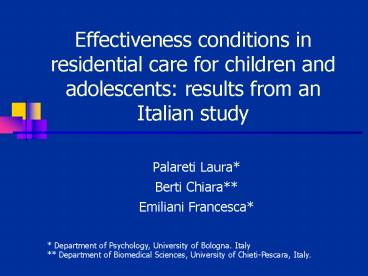Valutare le Comunit per minori PowerPoint PPT Presentation
1 / 15
Title: Valutare le Comunit per minori
1
Effectiveness conditions in residential care for
children and adolescents results from an Italian
study
Palareti Laura Berti Chiara Emiliani Francesca
Department of Psychology, University of
Bologna. Italy Department of Biomedical
Sciences, University of Chieti-Pescara, Italy.
2
Some premises
- Since the 70s, the institutes have gradually
been replaced by small, educational and
family-type communities. A law passed in 2001
decreed that by December 31st 2006 childrens
institutes in Italy were to be abolished once and
for all. - Current debate on the appropriateness of the
quality assessment criteria laid down by the
applicable regulations (i.e. authorization to
operate and accreditation) predominance of
structural and procedural-type criteria no
mention to outcomes and to relational aspects. - Methodological issues (heterogeneity of services
and settings, scarce information on the
implementation of a treatment program, no
experimental design) is it possible a
scientific evaluation of residential care?
3
Deinstitutionalization is not enough to conclude
that the alternative programs (family-type and
educational communities) effect a protective
function towards children in care.
Evaluation do we need a theory?
Theory-driven evaluation (Chen, 1990 2004)?
Black box evaluation (Scriven, 1998)?
outcomes
outcomes
Black Box
4
Ecological Model for the Evaluation of
Residential Care
Microsystem Activities, roles, and relations
within the community
Mesosystem Relational network between
microsystems which the child takes part in
(community / family / school / leisure)?
Exosystem System of relations between the
institutions that take care of the
child (community / social services / juvenile
court)?
Macrosystem Socio-cultural context of the
intervention (aims and theories that drive
interventions, legislation)
5
The project Quality evaluation of residential
care
Goals
- Describe interventions in real-world contexts
- referring to the 4 ecological level of
evaluation - including different stakeholders (residential
staff, adolescents in care, social services) - Clarify conditions under which residential
programs work or fail to work - Identify indicators that can be employed in the
quality evaluation of residential care
6
The Microsystem and its protective function
- Attachment theory (Bowlby, 1988)
- Warm and secure interpersonal relationships
- Therapeutic environment (Bettelheim, 1950 Redl
Wineman, 1951 Winnicott, 1965) - Physical environment
- Everyday routines, rituals and rules
- Meaningfulness
- Scaffolding and structuring function
7
Method
- Participants
- 59 adolescents in residential care (19
residential communities) for at least one year - age mean 16.2, range 12-19
- sex 33 M and 26 F
- 33 from Italy and 26 from other countries
- 22 offenders
- Instruments
- Ad hoc questionnaire with scales and open-ended
questions - Data from residential staff (n73) are not
presented here
8
Scales
- MICROSYSTEM
- Daily routines. For 12 routines two scales
- FREQUENCY with which they are practiced
- IMPORTANCE for the wellbeing of people in the
community - Perceived communication with favourite educator.
12 items adapted from the PACS (Barnes Olson,
1982) - OUTCOMES
- Adolescents satisfaction for the current
experience in residential care - Effects attributed to residential care
9
Hypothesis
- the relational climate in residential care
(analyzed by their everyday routines and
communication with the adult) is a good predictor
of the efficacy of the intervention
10
(No Transcript)
11
(No Transcript)
12
Verifying the Hypothesis Linear regression
analyses
13
Conclusions 1
- The results clarify the specific relationships
between dimensions of the intervention and
dimensions of the outcome. While the actual
possibility of sharing activities and dialogue
with the adult reflects on the satisfaction and
wellbeing of the adolescent, improvement from a
psychosocial adaptation point of view is linked
to the interiorization of the rules, patterns and
values proposed by the community. Lastly, for
adolescents to profoundly rethink their life
experience, it is also crucial to forge
meaningful relationships with adults.
14
Conclusions 2
- The results of this study not only confirm the
theoretical hypotheses on the link between the
relational climate in the community and the
effects of the intervention, but also question
the idea that residential care can be interpreted
-- and therefore evaluated -- merely as an array
of facilities, procedures or services without
identifying the theory on which this set of
resources and their organization is supposed to
bring about the desired change. - the absence of good logic models or theories of
change have meant that, even where there is some
indication that some aspects of the development
of some children benefit from periods of
residence, we have little idea why these
improvements are occurring (Little, Kohm
Thompson 2005)
15
Conclusions 3
- The choice made in this study to adopt the point
of view of adolescents expresses our conviction
about the importance of the way in which they
interpret their life experience and construct
explanations for change. - At present the systems for the quality evaluation
of services to people expect the user to express
his/her own point of view prevalently in terms of
satisfaction with the services received. Instead,
in our study, resident satisfaction is just one
dimension in the evaluation of residential care,
not only because in the psychological and
therapeutic field an effective intervention is
not always accompanied in its path by feelings of
satisfaction, but also because the way in which
adolescents interpret and explain their
experience of life in residential care
constitutes an ineluctable point of view for
evaluating the relation between the interventions
and the outcomes, and bears important
consequences for the actual objectives of the
intervention.

